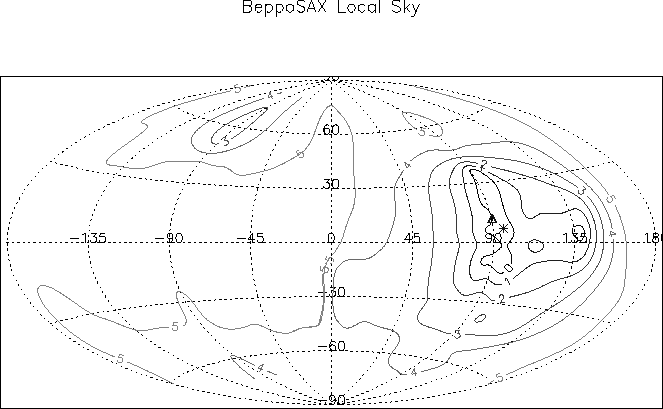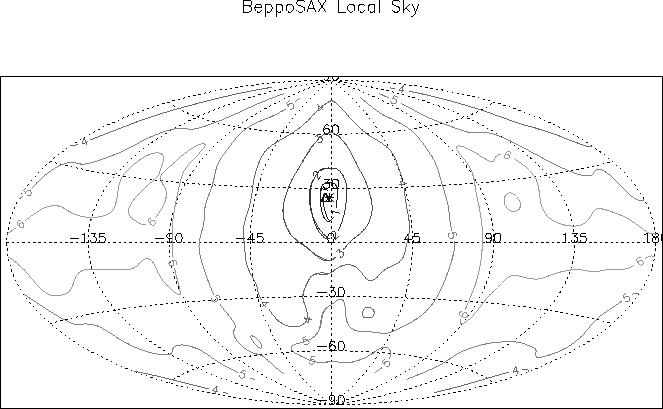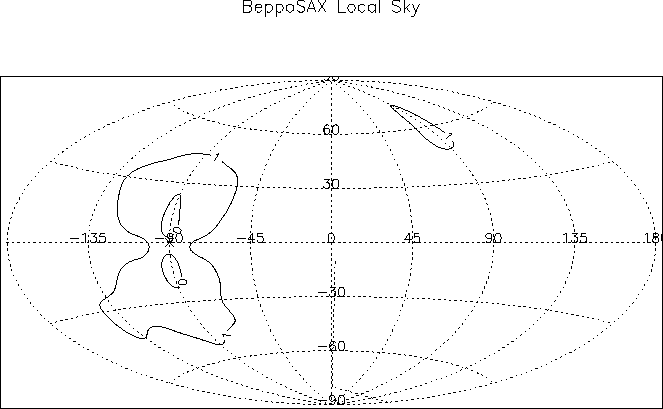 |
 |
In figg. ![[*]](crossref.png) and
and ![[*]](crossref.png) ,
some examples of GRB localizations are
shown: the frame of reference is local to BeppoSAX (an aitoff projection
has been used): fixed the elevation coordinate
,
some examples of GRB localizations are
shown: the frame of reference is local to BeppoSAX (an aitoff projection
has been used): fixed the elevation coordinate ![]() ,
the azimuthal coordinate
,
the azimuthal coordinate ![]() assumes the values 0, 90, 180 and 270
(-90 in the figure), when the direction faces the GRBM unit 2, 3, 4
and 1, respectively. Both cases concern bursts, whose direction has
been measured with high precision: GRB980109 was localized
by the WFC2 at coordinates R.A.= 0h 25m 56s, Decl. =
assumes the values 0, 90, 180 and 270
(-90 in the figure), when the direction faces the GRBM unit 2, 3, 4
and 1, respectively. Both cases concern bursts, whose direction has
been measured with high precision: GRB980109 was localized
by the WFC2 at coordinates R.A.= 0h 25m 56s, Decl. =
![]() (2000.0; in local coordinates:
(2000.0; in local coordinates:
![]() ,
,
![]() ),
with a
),
with a
![]() error radius (IAUC. 6805); this burst
triggered BATSE as well (trig. number: 6564).
GRB00516 was localized by means of an IPN triangulation (GCN 671),
thanks to Ulysses, BeppoSAX/GRBM, Konus/WIND and NEAR: its coordinates
were found to be R.A.= 2h 20 m 16.13 s, Decl.=
error radius (IAUC. 6805); this burst
triggered BATSE as well (trig. number: 6564).
GRB00516 was localized by means of an IPN triangulation (GCN 671),
thanks to Ulysses, BeppoSAX/GRBM, Konus/WIND and NEAR: its coordinates
were found to be R.A.= 2h 20 m 16.13 s, Decl.=
![]() (locally:
(locally:
![]() ,
,
![]() )
with a
)
with a ![]() error box area of
error box area of ![]() square arcminutes.
square arcminutes.
 |
Since the GRBM response matrix has been used to estimate the arrival
directions for about two hundreds GRBs detected with the only GRBM,
for which, therefore, there is no possibility to check the
accuracy of the localization with other experiments, it is fundamental
to know the systematic error and, in general, the limits introduced
by this technique.
On this subject a detailed discussion will follow in the next chapters,
when dealing with the results from the sample of bursts that were
localized by both the GRBM and other experiments.
These samples of common bursts have been used to calibrate
this technique and to test it.
Here we limit our attention to some remarks:
first, only for a subset of GRBs identified with the search algorithms,
which are the subject of this thesis, the localization
has come out to be meaningful: e.g., when the burst is faint,
its total counts in the GRBM units are affected by low
precision, and this poor knowledge turns into several and wide error
boxes in the sky, making the localization useless.
For this and other similar reasons,
when dealing with the localizations of the bursts described in this catalog,
several conditions had to be fulfilled in order to give a unique and
meaningful solution: this choice limited the number of bursts, for which
it was possible to estimate the incoming direction.
For instance, another (obvious) condition was that the candidate direction,
together with its whole error box, must be at least partially visible
(i.e., not Earth-blocked) from the BeppoSAX point of view.
For a detailed discussion of these criteria and of their related selection
effects on the sample of bursts localized with the GRBM, see
section ![[*]](crossref.png) .
.
 |
An example of multiple solution for the direction of
the same burst is given by GRB990627, UT 04:00:25
(fig. ![[*]](crossref.png) ).
This burst, missed by the on-board logic trigger, was quite bright on
the GRBM unit 3; the GRBM
).
This burst, missed by the on-board logic trigger, was quite bright on
the GRBM unit 3; the GRBM ![]() map for this burst suggests
three possible directions: two, pretty symmetrical, respectively above
and below the axis direction of unit 3, and, therefore, quite close
to the WFC 1 field of view (
map for this burst suggests
three possible directions: two, pretty symmetrical, respectively above
and below the axis direction of unit 3, and, therefore, quite close
to the WFC 1 field of view (
![]() );
the third one is found at
);
the third one is found at
![]() and
and
![]() .
Due to this ambiguity, this burst has not fulfilled all the requirements
for an acceptable localization, and for this it has not been included
in the sample of GRBM localized bursts.
.
Due to this ambiguity, this burst has not fulfilled all the requirements
for an acceptable localization, and for this it has not been included
in the sample of GRBM localized bursts.